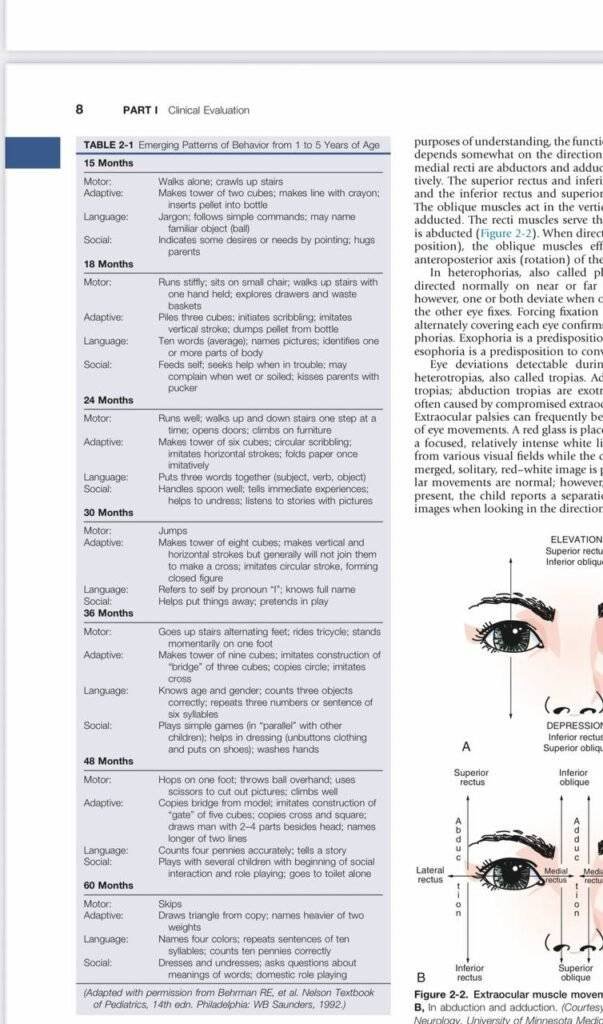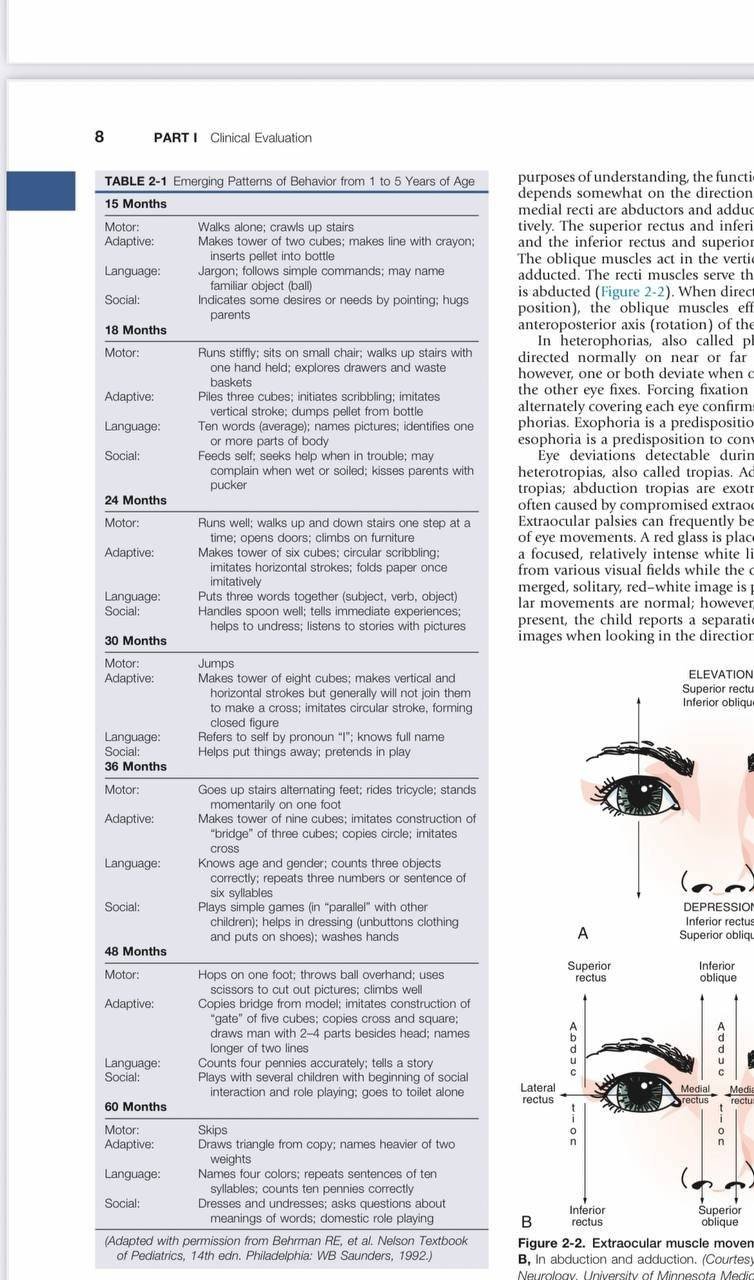Introduction
Normal behavioral development in children is a vital aspect of early childhood health and growth. It is influenced by genetic, environmental, and social factors. Pediatricians, neurologists, and caregivers closely monitor milestones in physical, emotional, cognitive, and social domains to ensure that a child’s development is progressing as expected. Understanding what constitutes normal behavior at various age levels allows for early detection of developmental delays or disorders. This article provides a comprehensive overview of normal child behavior from 15 months to 5 years of age, with developmental patterns categorized by motor, adaptive, language, and social skills. The data is adapted from a trusted clinical resource and is intended for medical professionals, students, and parents interested in early childhood development.
15 Months
Motor
By 15 months, a child typically begins to walk independently and may start crawling up stairs. This is a pivotal time for gross motor skill development, where balance and coordination are improving.
Adaptive
Children at this stage demonstrate early fine motor skills. They can make a tower of two cubes, draw a line with a crayon, and insert pellets into a bottle. These actions show increasing dexterity and hand-eye coordination.
Language
Language at 15 months is mostly jargon, with children beginning to follow simple commands. They may also name familiar objects like a “ball.” Receptive language (understanding) often exceeds expressive language (speaking) at this age. Social Socially, children start expressing their needs or desires through gestures like pointing. They show affection by hugging caregivers and are more interactive with familiar adults.
18 Months
Motor
At 18 months, a child typically runs stiffly, sits on a small chair, and can walk up stairs with one hand held. They begin exploring more independently, including opening drawers and carrying baskets.
Adaptive
This is a time of significant progress in fine motor control. Children can pile three cubes, initiate scribbling, and imitate vertical strokes. They may also be able to dump pellets from a bottle.
Language
An average 18-month-old knows about ten words. They can name pictures, identify one or more body parts, and use single words to communicate their needs or interests.
Social
Feeding themselves becomes more common at this age. Children seek help when in distress and may express discomfort when wet or soiled. Early signs of affection include kissing parents with a puckered mouth
24 Months (2 Years)
Motor
By age 2, most children run well and can walk up and down stairs one step at a time. They can also open doors and climb onto furniture independently.
Adaptive
Children build a tower of six cubes and begin circular scribbling. They can imitate horizontal strokes and fold paper once, demonstrating increasing coordination and imitation skills.
Language
Two-year-olds often put three words together in a sentence, commonly following the “subject-verb-object” structure, e.g., “Mommy eat cookie.”
Social
They handle a spoon well and begin to tell simple experiences. Social behavior includes helping with dressing and listening to stories with pictures. Children may also start expressing more autonomy in daily routines.
30 Months (2.5 Years)
Motor
At this stage, children begin to jump, which demonstrates improved balance and muscle strength.
Adaptive
They can build a tower of eight cubes and make both vertical and horizontal strokes. However, they may not yet be able to combine these strokes to form a cross. They can imitate a circular stroke and form a closed figure.
Language
Children start referring to themselves using the pronoun “I” and know their full name. This represents a cognitive leap in self-awareness.
Social
Socially, they help put things away and engage in pretend play. Imitation of adult roles during play becomes more evident, which is a sign of developing imagination and empathy.
36 Months (3 Years)
Motor
Three-year-olds are able to go up stairs using alternating feet, ride a tricycle, and stand momentarily on one foot. These are significant milestones in gross motor coordination.
Adaptive
They can make a tower of nine cubes and imitate the construction of a bridge using three cubes. They also begin copying circles and can imitate a cross.
Language
At this age, children typically know their age and gender. They can count three objects correctly and may repeat three numbers or a sentence consisting of six syllables. Vocabulary expands rapidly, and pronunciation becomes clearer.
Social
Play becomes more interactive, although still mostly in “parallel” with other children rather than truly cooperative. They can help in dressing (e.g., unbuttoning clothes and putting on shoes) and wash their hands independently.
48 Months (4 Years)
Motor
Four-year-olds can hop on one foot, throw a ball overhand, use scissors to cut out simple shapes, and climb well. These skills demonstrate refined gross and fine motor coordination.
Adaptive
They can copy a bridge from a model and imitate the construction of a “gate” using five cubes. They can copy a cross and square and draw a man with 2–4 body parts. Additionally, they begin writing or drawing longer lines and show control over drawing tools.
Language
Children at this stage can count four pennies accurately and begin to tell stories. They understand sequencing and time-based events better, using language to communicate more complex thoughts.
Social
Socially, they engage with several children at once and begin meaningful social interaction. Role-playing games (e.g., pretending to be a parent or doctor) become a common feature of play. They also achieve toilet independence.
60 Months (5 Years)
Motor
By five years of age, children can skip, which indicates advanced coordination and motor planning skills.
Adaptive
They can draw a triangle from a copy and compare the weight of two objects, distinguishing heavier from lighter items. These tasks require more sophisticated visual-spatial reasoning and problem-solving abilities.
Language
Language use becomes much more refined. Children can name four colors, repeat sentences with ten syllables, and count ten pennies correctly. Their understanding of syntax, grammar, and vocabulary becomes clearer.
Social
At this age, children can dress and undress themselves, including managing buttons and zippers. They ask questions about the meanings of words and engage in more structured and imaginative domestic role-playing scenarios.
Summary Table of Normal Child Development from 15 Months to 5 Years

Understanding the normal range of behaviors from 15 months to 5 years is critical for monitoring a child’s development. While every child grows at their own pace, these age-specific milestones provide a guideline to identify typical patterns and early signs of developmental concerns. Delays in achieving these milestones may warrant further evaluation and early intervention to ensure the best outcomes. Healthcare providers and parents should collaborate to monitor these behavioral domains regularly. Encouraging environments that stimulate movement, speech, and social interaction can significantly support healthy development in early childhood.

No responses yet